MENU
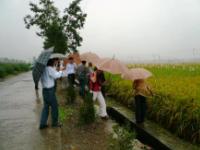
|
| FNCA 2005 WORKSHOP ON MUTATION BREEDING |
|
FNCA 2005 Workshop on Mutation Breeding took place as follows,
Date: December 5– 9, 2005
Venue: Legend Hotel, Kuala Lumpur, Malaysia
Malaysian Institute for Nuclear Technology Research (MINT), Bangi, Malaysia
Host Organizations:
Malaysian Institute for Nuclear Technology Research
(MINT)
Ministry of Education, Culture, Sport, Science and Technology (MEXT), Japan
Secretariat: Japan Atomic Industrial Forum Inc. (JAIF)
Participants: Total 29 from 8 countries, i.e. China, Indonesia, Japan, Korea, Malaysia, the Philippines, Thailand and Vietnam plus 7 observers from Malaysia.
Opening Session:
The opening session began with the remarks by Dr. Mohd Nazir Basiran on behalf of MINT, Ms. Miwako Shimizu on behalf of MEXT, followed by the o pening address by Dr. Daud Mohamad, Director General of MINT on behalf of YB Dato' Sri Dr. Jamaludin bin Mohd Jarjis,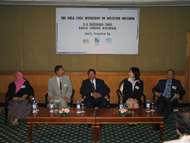 the Honorable Minister of Science, Technology and Innovation, Malaysia . the Honorable Minister of Science, Technology and Innovation, Malaysia .
The official opening ceremony was followed by “Memorial Speech for the late Dr. Tano” and “Overview of FNCA Mutation Breeding Project” presented by Dr. Hitoshi Nakagawa, Project Leader of Japan as introduction to the Workshop.
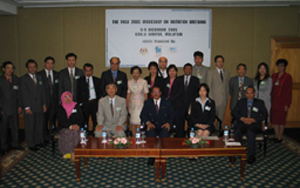
Session 1: Sub-Project on “Drought Tolerance in Soybean and Sorghum”
Progress reports on “Drought Tolerance in 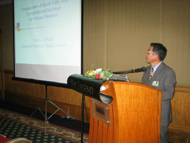 Sorghum” were delivered by China, Indonesia and Japan. Sorghum” were delivered by China, Indonesia and Japan.
Keynote speech on Soybean was delivered by Prof. Yutaka Takagi, Japan, followed by progress reports on “ Drought Tolerance in Soybean” by Indonesia, Malaysia, the Philippines and Vietnam.
“ Present Status and Future Work Plan of the Sub-Project on Drought Tolerance in Soybean and Sorghum” were discussed and the points discussed are included in “Summary of Sub-Project Activities” . The points agreed upon are summarized in “Minutes of Workshop” .
Session2:
Special Topic
Four Special Topics were presented by Japan, Korea and Malaysia as follows. The details of presentations are summarized in “Minutes of Workshop”.
- “Research Progress and Current Status of Mutation Breeding in Korea” by Dr. Si-Yong Kang , Korea.
- “ New Rice Cultivars with Low Levels of Easy-to-Digest Protein” by Dr. Minoru Nishimura, Japan
- “Mutation Breeding of Roselle in Malaysia ” by Assoc. Prof. Dr. Mohamad Osman, Malaysia
- “Induced Mutation for the Improvement of Papaya (Carica papaya) and Pineapple (Ananas comosus) in Malaysia” by Dr. Rusli Ibrahim, Malaysia
Session 3: Sub-Project on “Insect Resistance in Orchid”
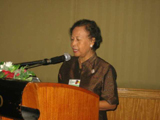 Report on the sub-project meeting on Insect Resistance in Orchid which was held on September 5-8, 2005 in Bangkok, Thailand was presented by Prof. Siranut Lamseejan, Thailand. After presentation, mid-term report on orchid and future working plan were discussed and accepted. Report on the sub-project meeting on Insect Resistance in Orchid which was held on September 5-8, 2005 in Bangkok, Thailand was presented by Prof. Siranut Lamseejan, Thailand. After presentation, mid-term report on orchid and future working plan were discussed and accepted.
Session4: General discussion
Mutation Breeding Database (MBDB) and Mutation Breeding Manual (MBM) were reported by Japan. The details of discussion are summarized in “Minutes of Workshop” . The points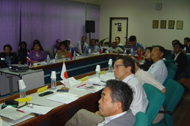 suggested and agreed upon are as follows; suggested and agreed upon are as follows;
- Publications including the country reports from each participating countries for the proposed MUTATION BREEDING PUBLICATION DATABASE should be submitted to FNCA secretariat by the end of April 2006.
- The Mutation Breeding Database is not ready to be shared outside of FNCA network due to confidentiality of certain information.
- The hard copy of the Mutation Breeding Manual was distributed to every participant and it was suggested that the Mutation Breeding Manual be registered for ISBN number, though it is recommended that FNCA acknowledges the use of materials and references from outside sources.
Session 5: Sub-Project on “Disease Resistance in Banana”
Keynote Speech was delivered by Dr. Keiko Natsuaki, Japan, followed by progress reports on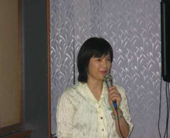 “Disease Resistance in Banana ” by Indonesia, Malaysia, the Philippines and Vietnam. “ Present Status and Future Work Plan of the Sub-Project on Disease Resistance in Banana ” was discussed and the points discussed are included in “Summary of Sub-Project Activities” . The points agreed upon are summarized in “Minutes of Workshop” “Disease Resistance in Banana ” by Indonesia, Malaysia, the Philippines and Vietnam. “ Present Status and Future Work Plan of the Sub-Project on Disease Resistance in Banana ” was discussed and the points discussed are included in “Summary of Sub-Project Activities” . The points agreed upon are summarized in “Minutes of Workshop”
Session6: Round Table Discussion 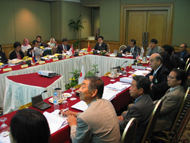
Future plans proposed and the details of discussion are summarized in “Minutes of Workshop” . The points agreed by the participants are as follows;
- In phase IV, the mutation breeding activity will be focused on problem solving project.
- The FNCA 2006 Workshop for Mutation Breeding will be hosted by Japan between late August and early September. Korea will host the 2007 Workshop.
- The sub-project meeting on Insect Resistance in Orchid held in Bangkok was found to be very beneficial, therefore the sub-project meeting on Disease Resistance in Banana will be held separately in the Philippines in July 2006.
- Suggestion that Project Leaders should lead at least one sub-project that the country is participating in was made by FNCA.
- The proposed project “Composition or Quality Crop Breeding” was selected as a new project to be implemented from 2007 on mainly rice, soybean, wheat and sorghum etc. Initially all countries (China, Indonesia, Japan, Korea, Malaysia, the Philippines, Thailand and Vietnam) have agreed to participate in the project, which will be discussed further until the next workshop.
Technical Visit:
Participants made a visit to Gamma Greenhouse construction site at MINT with a 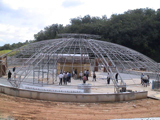 briefing on the gamma greenhouse as well as the ongoing construction work at the Gamma Greenhouse by Dr. Rusli Ibrahim. briefing on the gamma greenhouse as well as the ongoing construction work at the Gamma Greenhouse by Dr. Rusli Ibrahim.
In conjunction with the invited lecture on “Mutation Breeding of Roselle in Malaysia” by Dr. Mohamad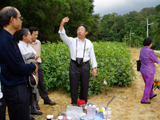 Osman, the participants visited the Roselle ( Hibiscus sabdariffa ) experimental plots at Universiti Kebangsaan Malaysia, to observe the screening and evaluation of Roselle mutants. All participants had the chance to see the plants in the field, demonstration of various Roselle products and tasted Roselle juice and dried sweet pickles. Osman, the participants visited the Roselle ( Hibiscus sabdariffa ) experimental plots at Universiti Kebangsaan Malaysia, to observe the screening and evaluation of Roselle mutants. All participants had the chance to see the plants in the field, demonstration of various Roselle products and tasted Roselle juice and dried sweet pickles.
Participants also visited Kulim Montel Farm, Kluang, Johor and Malaysian Agricultural Research and Development Institute (MARDI), Pontian Station, Pontian, Johor.
At Kulim Montel Farm, Mr. Roslan Osman, The Farm Manager, briefed all participants on the operation of the banana farm, including the packaging process.
At the MARDI station, a research officer, Ms. Kogee gave brief information of research activities at MARDI Pontian. This was followed by a presentation by Dr. Chan Ying Kwok on the project on papaya improvement at MARDI which include the application of mutation breeding technique. The participants were given the opportunity to visit The Pineapple Museum as well as pineapple and papaya planting plots. Dr. Chan also gave a demonstration on the techniques for pollinating pineapples.
|
|
MINUTES OF FNCA 2005 WORKSHOP ON MUTATION BREEDING
December 5 – 9, 2005
Kuala Lumpur, MALAYSIA
Following the agreement at the Sixth Coordinators Meeting on March 30-April 1, 2005 in Tokyo, Japan, the FNCA 2005 Workshop on Mutation Breeding took place as follows,
Date: December 5– 9, 2005
Venue:
Legend Hotel, Kuala Lumpur, Malaysia
Malaysian Institute for Nuclear Technology Research (MINT), Bangi, Malaysia
Host Organizations:
- Malaysian Institute for Nuclear Technology Research (MINT)
- Ministry of Education, Culture, Sport, Science and Technology (MEXT), Japan
Secretariat: Japan Atomic Industrial Forum Inc. (JAIF)
Participants: Total 29 from 8 countries, i.e. China, Indonesia, Japan, Korea, Malaysia, the Philippines, Thailand and Vietnam
plus 7 observers from Malaysia.
Opening Session:
The opening session began with the remarks by Dr. Mohd Nazir Basiran on behalf of MINT, Ms. Miwako Shimizu on behalf of MEXT, followed by the o pening address by Dr. Daud Mohamad, Director General of MINT on behalf of YB Dato' Sri Dr. Jamaludin bin Mohd Jarjis, the Honorable Minister of Science, Technology and Innovation, Malaysia .
The official opening ceremony was followed by “Memorial Speech for the late Dr. Tano” and “Overview of FNCA Mutation Breeding Project” presented by Dr. Hitoshi Nakagawa, Project Leader of Japan as introduction to the Workshop.
Session 1: Sub-Project on “Drought Tolerance in Soybean and Sorghum”
Progress reports on “Drought Tolerance in Sorghum” were delivered by China, Indonesia and Japan.
Keynote speech on Soybean was delivered by Prof. Yutaka Takagi, Japan, followed by progress reports on “ Drought Tolerance in Soybean” by Indonesia, Malaysia, the Philippines and Vietnam.
“ Present Status and Future Work Plan of the Sub-Project on Drought Tolerance in Soybean and Sorghum” were discussed and the points discussed are included in the appendix III . The points agreed upon are as follows;
<Sorghum>
Participating countries (Indonesia & China) have developed total eleven (Indonesia 10, China 1) mutant lines having desirable agronomic traits, good quality and tolerant to drought. These breeding materials have been exchanged between counterparts of Indonesia and China for breeding program. Demonstration plots for the released sweet sorghum mutant variety (Yuantian 1) were conducted in China. In Indonesia, seed multiplication of drought tolerant mutant lines was conducted by project counterpart i.e. LIPPO enterprise for multilocational trials. Ion beam induced breeding materials are now being studied in Indonesia, China and Japan. The same ion beam irradiated materials are being evaluated in Indonesia and Japan. Sorghum based industry for food, animal feed and materials has been developed in each participating countries. This will give significant impact to farmers and could promote economic growth.
<Soybean>
For The Philippines, six promising mutant lines have been selected in the local varieties (PSB-Sy5, BPI-Sy4 and PSB-Sy4) and in Vietnamese varieties (DT-95, AKO-6 and DT-84). Malaysia reported that PSB-Sy4, an introduced variety from the Philippines was selected as a potential candidate because of its earliness and drought tolerance. According to Indonesia, the control variety has 2.22tons/ha yield which was higher than all the materials tested. M220 is a promising mutant line with a yield of 2.14tons/ha. The yield was better than the introduced line. The M220 will be further developed for drought tolerance and higher yield. Vietnam reported that there were 10 mutants and hybrid varieties that have been released that contributed to increase in soybean yield. Recently, Institute of Agricultural Genetics (IAG) is applying gamma radiation in 3 soybean varieties (DT96, DT2001 and D.158) for drought tolerance studies. Mutant lines with drought tolerance have been selected.
Session2: Special Topic
Four Special Topics were presented by Japan, Korea and Malaysia. The summary of presentations is as follows;
- In Korea, registration of a newly developed plant variety needs to go through the National Seed Management Office, which is under the Ministry of Agriculture and Forest. In Korea, it takes at least 10 years duration for breeding and 2 years for registration of a new variety and the released varieties are protected. Korea mentioned that an average of 5 tons /ha of rice yield is considered breeding target for saline tolerant rice cultivar.
- In Japan, a new cultivar, LGC1, was developed with a low glutelin and high prolamine content by mutation breeding. Because of the indigestibility of prolamine, LGC1 can be used practically as low protein rice. It is useful for people who must restrict their protein intake, such as patients with kidney disease. The molecular characterization of Low glutelin content 1 ( Lgc1 ) has been reported. Two new cultivars were also developed from a cross between LGC1 and a mutant line that is deficient in 26-kDa globulin. These cultivars were registered with the Japanese Ministry of Agriculture, Forestry and Fisheries. These cultivars have about half the easy-to-digest protein content of regular cultivars.
- Roselle juice is well accepted by public in Malaysia. Roselle has many beneficial components such as high Anthocyanin, high Vitamin C and may contain HCA (Hydroxycitric acid) that has potential use in slimming products.
- In Malaysia, grafting of Papaya is a common method to propagate hermaphrodite plants. Fruit from hermaphrodite plants are favoured compared to fruits from male and female plants.
- In pineapple micropropagation, l.0 liter temporary immersion and 5.0 liter air-lift bioreactors are used.
Session3: Sub-Project on “Insect Resistance in Orchid”
Report on the sub-project meeting on Insect Resistance in Orchid which was held on September 5-8, 2005 in Bangkok, Thailand was presented by Prof. Siranut Lamseejan, Thailand. After presentation, mid-term report on orchid and future working plan were discussed and accepted.
Session4: General discussion
Mutation Breeding Database (MBDB) and Mutation Breeding Manual (MBM) were reported by Japan. The points suggested and agreed upon are as follows;
- Publications (full paper or abstract in English) for the proposed MUTATION BREEDING PUBLICATION DATABASE should be submitted to FNCA secretariat by the end of April 2006.
- FNCA proposal to put the country reports from each participating countries into the MUTATION BREEDING PUBLICATION DATABASE was accepted.
- The Mutation Breeding Database is not ready to be shared outside of FNCA network due to confidentiality of certain information.
- The hard copy of the Mutation Breeding Manual was distributed to every participant and FNCA demonstrated and explained how to access to Mutation Breeding Manual through the Internet.
- Indonesia suggested that the Mutation Breeding Manual be registered for ISBN number. If there were ISBN number, it would be an official publication and made known outside of FNCA circle. However, it is recommended that FNCA acknowledges the use of materials and references from outside sources.
Session5: Sub-Project on “Disease Resistance in Banana”
Keynote Speech was delivered by Dr. Keiko Natsuaki, Japan, followed by progress reports on “Disease Resistance in Banana ” by Indonesia, Malaysia, the Philippines and Vietnam.
“ Present Status and Future Work Plan of the Sub-Project on Disease Resistance in Banana ” was discussed and the points discussed are included in the appendix III . The points agreed upon are as follows;
In the Philippines, Screening for BBTV has been done for generation 1 & 2 of the promising mutant lines and 2 lines have been evaluated against nematodes. Out of the 43 PR BBTV lines, 13 showed resistance to BBTV under field condition. One PR line each was resistant to nematodes caused by R. similis & M. incognita . For Indonesia, Malaysia and Vietnam, evaluation of promising PR lines resistant/tolerant to Fusarium wilt was done in greenhouse and hot spot areas. In Vietnam 17 promising mutant lines were identified for the resistant for Fusarium wilt under greenhouse condition. In Malaysia, greenhouse screening for Fusarium wilt was done using double tray technique under greenhouse condition. At the same time, 3000 irradiated plants have been screened in hot spot areas in collaboration with a private company, United Plantations Bhd. Those two techniques failed to select resistant plants to Fusarium wilt disease. Therefore, suggestion was made to conduct appropriate greenhouse evaluation to identify putative mutant lines.
Session6: Round Table Discussion
Future plans proposed and agreed by the participants are as follows;
- In phase IV, the mutation breeding activity will be focused on problem solving project. FNCA emphasized on the evaluation for economic and social impacts of the sub-projects.
- The FNCA 2006 Workshop for Mutation Breeding will be hosted by Japan between late August and early September. Korea will host the 2007 Workshop.
- The sub-project meeting on Insect Resistance in Orchid held in Bangkok was found to be very beneficial, therefore the sub-project meeting on Disease Resistance in Banana will be held separately in the Philippines in July 2006. Sub-project meeting should also include experts and users to help researchers on specific problems regarding the project.
- Suggestion that Project Leaders should lead at least one sub-project that the country is participating in was made by FNCA.
- Korea proposed four candidate projects to be implemented from 2007. Among the four projects, the project “Composition or Quality Crop Breeding” was selected on mainly rice, soybean, wheat and sorghum etc. Initially all countries (China, Indonesia, Japan, Korea, Malaysia, the Philippines, Thailand and Vietnam) have agreed to participate in the project. The format for constructing the new project will be sent from FNCA secretariat and the detail of the project will be discussed further until the next workshop.
Technical Visit
Participants made a visit to Gamma Greenhouse construction site at MINT with a briefing on the gamma greenhouse as well as the ongoing construction work at the Gamma Greenhouse by Dr. Rusli Ibrahim. In conjunction with the invited lecture on “Mutation Breeding of Roselle in Malaysia” by Dr. Mohamad Osman, the participants visited the Roselle ( Hibiscus sabdariffa ) experimental plots at Universiti Kebangsaan Malaysia, to observe the screening and evaluation of Roselle mutants. All participants had the chance to see the plants in the field, demonstration of various Roselle products and tasted Roselle juice and dried sweet pickles.
These visits were followed by field visits to Kulim Montel Farm, Kluang, Johor and Malaysian Agricultural Research and Development Institute (MARDI), Pontian Station, Pontian, Johor. At Kulim Montel Farm, Mr. Roslan Osman, The Farm Manager, briefed all participants on the operation of the banana farm, including the packaging process. At the MARDI station, a research officer, Ms. Kogee gave brief information of research activities at MARDI Pontian. This was followed by a presentation by Dr. Chan Ying Kwok on the project on papaya improvement at MARDI which include the application of mutation breeding technique. The participants were given the opportunity to visit The Pineapple Museum as well as pineapple and papaya planting plots. Dr. Chan also gave a demonstration on the techniques for pollinating pineapples.
The Minutes were discussed and agreed upon by all participants in the Workshop. This will be reported at the Seventh FNCA Coordinators Meeting to be held in March 2006 in Tokyo, Japan.
Appendixes:
1. Program of FNCA 2005 Workshop on Mutation Breeding
2. Participants List of FNCA 2005 Workshop on Mutation Breeding
3. Summary of FNCA Mutation Breeding Sub-Project Activities by FY2005
4. Three Years Plan for FNCA Mutation Breeding Project
|
PROGRAM OF
FNCA 2005 MUTATION BREEDING WORKSHOP
DECEMBER 5 – 9, 2005
KUALA LUMPUR, MALAYSIA
Date |
: |
December 5 – 9, 200 5 |
|
Venue |
: |
Legend Hotel, Kuala Lumpur , Malaysia
Malaysian Institute for Nuclear Technology Research (MINT), Bangi, Malaysia
|
|
Host Organization |
: |
Malaysian Institute for Nuclear Technology Research (MINT) |
|
Sponsor |
: |
Ministry of Education, Culture, Sport, Science and Technology (MEXT), Japan |
|
Secretariat |
: |
Japan Atomic Industrial Forum Inc. (JAIF) |
|
Working Language |
: |
English |
|
|
|
|
|
| Sun, 4 December |
: |
Arrival of Participants |
|
|
|
|
|
| Mon, 5 December |
|
|
|
08.30-09.00 |
: |
Registration |
|
09.00-09.30 |
: |
Welcome Address by MINT |
|
|
: |
Welcoming Remarks by MEXT |
|
9.30-9.45 |
|
Opening Address by Honorable Minister of Science, Technology and Innovation , Malaysia |
|
9.45-10.10 |
: |
BREAK and GROUP PHOTO |
|
10.10-10.15 |
: |
Memorial Speech for the late Dr. Tano by Dr. Nakagawa, Japan |
|
10.15-10.30 |
|
Overview of FNCA Mutation Breeding Project by Dr. Hitoshi Nakagawa, Japan |
|
|
|
|
|
Session 1 : Sub-Project on “Drought Tolerance in Soybean and Sorghum”
Chair: Indonesia |
|
10.30-11.00 |
: |
Progress Report for Sorghum by China ( Prof. Liu Luxiang ) |
|
11.00-11.30 |
: |
Progress Report for Sorghum by Indonesia (Dr. Soeranto Human) |
|
11.30-12.00 |
|
Presentation for Sorghum by Japan (Dr. Hitoshi Nakagawa) |
|
12.00-13.00 |
: |
Discussion on Sorghum |
|
13.00-14.00 |
: |
LUNCH |
|
Continuation of Session 1 : Sub-Project on “Drought Tolerance in Soybean and Sorghum”
Chair: Vietnam
|
|
14.00-14.45 |
: |
Keynote Speech on Soybean by Prof. Yutaka Takagi, Japan |
|
14.45-15.15 |
: |
Progress Report for Soybean by Indonesia (Dr. Masrizal) |
|
15.15-15.30 |
: |
BREAK |
|
15.30-16.00 |
: |
Progress Report for Soybean by Malaysia (Assoc. Prof. Dr. Mohamad Osman) |
|
16.00-16.30 |
|
Progress Report for Soybean by the Philippines ( Ms. Avelina Gutierrez Lapade ) |
|
16.30-17.00 |
: |
Progress Report for Soybean by Vietnam (D r. Mai Quang Vinh ) |
|
17.00-18.00 |
|
Discussion on Soybean |
|
20.00 |
: |
Reception hosted by MINT and JAIF |
|
|
|
|
|
| Tue, 6 December |
|
|
|
Continuation of Session 1 : Sub-Project on “Drought Tolerance in Soybean and Sorghum”
Chair: Japan
|
|
09.00-10.30 |
: |
Discussion on Present Status and Future Work Plan of the Sub-Project on Drought Tolerance in Soybean and Sorghum |
|
10.30-10.50 |
: |
BREAK |
|
|
|
Session 2 : Special Topic
Chair: China
|
|
11.00-11.30 |
|
Presentation by Korea: “ Research Progress and Current Status of Mutation Breeding in Korea ” ( Dr. Si-Yong Kang ) |
|
11.30-12.00 |
: |
Presentation by Japan : “ New R ice C ultivars with L ow L evels of E asy-to- D igest P rotein ” ( Dr. Minoru Nishimura ) |
|
12:00-12:30 |
|
Invited Lecture by Malaysia 1: “Mutation Breeding of Roselle in Malaysia ” (Assoc. Prof. Dr. Mohamad Osman) |
|
12:30-13:00 |
: |
Invited Lecture by Malaysia 2: “Induced Mutation for the Improvement of Papaya (Carica papaya) and Pineapple (Ananas comosus) in Malaysia” (Dr. Rusli Ibrahim) |
|
13.00-14.00 |
: |
LUNCH |
|
Session 3 : Sub-Project on “Insect Resistance in Orchid”
Chair: Thailand
|
|
14.00-14.30 |
|
Report of the Sub-Project Meeting on Insect Resistance in Orchid and Mid-term Evaluation by Prof. Dr. Siranut Lamseejan , Thailand |
14.30-15.30 |
: |
Discussion on Orchid and Mid-term Evaluation |
15.30-15.50 |
|
BREAK |
Session 4: General Discussion
Chair: Japan
|
|
15.50-16.10 |
|
Report of Mutation Breeding Database (MBDB) and Mutation Breeding Manual (MBM) by Dr. Hitoshi Nakagawa, PL of Japan |
16.10-17.00 |
|
Discussion on MBDB and MBM |
|
|
|
| Wed, 7 December |
|
|
Session 5: Sub-Project on “Disease Resistance in Banana”
Chair: Korea
|
09.00-09.40 |
: |
Keynote Speech by Dr. Keiko Natsuaki, Japan |
09.40-10.10 |
: |
Progress Report for Banana by Indonesia (Dr. Ishak) |
10.10-10.40 |
: |
Progress Report for Banana by Malaysia (Dr. Rusli Ibrahim) |
10.40-11.00 |
: |
BREAK |
Continuation of Session 5 :
Sub-Project on “Disease Resistance in Banana”
Chair: Philippines
|
|
11.00-11.30 |
: |
Progress Report for Banana by the Philippines ( Dr. Teodora Ocampo Dizon ) |
11:30-12:00 |
: |
Progress Report for Banana by Vietnam ( Dr. Dang Trong Luong ) |
12.00-13:00 |
: |
Discussion on Present Status and Future Work Plan of the Sub-Project on Disease Resistance in Banana |
13.00-14.00 |
: |
LUNCH |
14:00-17.00 |
: |
Technical Visits:
Gamma Greenhouse MINT
Roselle experimental plots , University Kebangsaan Malaysia
|
|
|
|
| Thu, 8 December |
|
|
Technical Visits:
Kulim Montel Farm, Kluang, Johor
Malaysian Agriculture Research and Development Institute (MARDI) Station, Pontian, Johor. |
|
07.00 |
: |
Leave Legend Hotel, Kuala Lumpur |
12.00-13.00 |
: |
Visit to Kulim Montel Farm |
13.00-14.00 |
: |
LUNCH at MARDI |
14.00-14:15 |
: |
Briefing by Manager , MARDI Station |
14.15-14:30 |
: |
Briefing by Dr. Chan Ying Kwok on Research Activities of P ineapple and P apaya |
14.30-16.00 |
: |
Visit P ineapple and P apaya Experimental Plots |
|
|
|
| Fri, 9 December |
|
|
Session 6 : Round Table Discussion
Chair: Japan and Malaysia
|
09.00-10.00 |
: |
Discussion on Future Plan and Prospect of MB Project |
10.00-10.15 |
: |
Break |
10.15-12.15 |
: |
Drafting minutes |
12.15-14.30 |
: |
LUNCH |
14.30-15.30 |
: |
Wrap-up: adoption of the minutes |
15.30-16.00 |
: |
Closing |
|
|
|
| Sat, 10 December |
: |
Departure of participants |
|
|
PARTICIPANTS LIST
OF FNCA 2005 WORKSHOP ON MUTATION BREEDING
December 5 – 9, 2005
Kuala Lumpur, MALAYSIA
Country |
Name |
Address |
China |
1. Dr. Lu Daguang |
Program officer
China-IAEA/RCA Coordination Office
Dept. of International Cooperation
Chinese Academy of Agricultural Sciences (CAAS) |
2. Prof. Liu Luxiang |
Director
Dept. of Plant Mutation Breeding & Genetics
Institute of Crop Science
Chinese Academy of Agricultural Sciences (CAAS)
|
Indonesia |
3. Dr. Masrizal |
Assistant Deputy for Development of National Science and Technology SystemState Ministry for Research and Technology |
4. Dr. Soeranto Human |
Plant Breeder
National Nuclear Energy Agency (BATAN)
|
5. Dr. Ishak |
Evaluation of Fusarium Resistant banana mutant
R&D Center for Isotopes and Radiation Technology (CRDIRT)
National Nuclear Energy Agency (BATAN)
|
Japan |
6. Dr. Hitoshi Nakagawa |
Director
Institute of Radiation Breeding (IRB)
National Institute of Agrobiological Sciences (NIAS)
|
7. Dr. Keiko Natsuaki |
Professor
Faculty of International Agriculture and Food Studies
Tokyo University of Agriculture
|
8. Dr. Minoru Nishimura |
Head
Mutation Genetics Laboratory
Institute of Radiation Breeding (IRB)
National Institute of Agrobiological Sciences (NIAS)
|
9. Prof. Yutaka Takagi |
Professor emeritus
Saga University
|
10. Ms. Miwako Shimizu |
Special Staff
Atomic Energy Division
Research and Development Bureau
Ministry of Education, Culture, Sports, Science and Technology (MEXT)
|
11. Mr. Takao Nagasaki |
Project Manager
Asia Cooperation Center (ACC)
Japan Atomic Industrial Forum (JAIF)
|
12. Ms. Yuko Wada |
Senior Staff
Asia Cooperation Center (ACC)
Japan Atomic Industrial Forum (JAIF)
|
Korea |
13. Dr. Si-Yong Kang |
Principal Researcher, Project Leader
Advanced Radiation Technology Institute (ARTI)
Korea Atomic Energy Research Institute (KAERI)
|
Malaysia |
14. Dr. Mohd Nazir Basiran |
Manager
Ornamental Group
Agrotechnology and Biosciences Division
Malaysian Institute for Nuclear Technology Research (MINT)
|
15. Assoc. Prof. Dr. Mohamad Osman |
Associate Professor
Malaysia
School of Environmental and Natural Resource Sciences
Faculty of Science and Technology
Universiti Kebangsaan Malaysia (UKM) |
16. Dr. Rusli Ibrahim |
Manager
Industrial Crop Group
Agrotechnology and Biosciences Division
Malaysian Institute for Nuclear Technology Research (MINT) |
17. Dr. Zaiton Ahmad |
Research Officer
Ornamental Group
Agrotechnology and Biosciences Division
Malaysian Institute for Nuclear Technology Research (MINT)
|
18. Ms. Shakinah Salleh |
Research Officer
Ornamental Group
Agrotechnology and Biosciences Division
Malaysian Institute for Nuclear Technology Research (MINT)
|
19. Ms. Sakinah Ariffin |
Research Officer
Ornamental Group
Agrotechnology and Biosciences Division
Malaysian Institute for Nuclear Technology Research (MINT)
|
20. Ms. Affrida Abu Hassan |
Research Officer
Ornamental Group
Agrotechnology and Biosciences Division
Malaysian Institute for Nuclear Technology Research (MINT)
|
21. Ms. Alvina Lindsay Mijen |
Research Officer
Industrial Crop Group
Agrotechnology and Biosciences Division
Malaysian Institute for Nuclear Technology Research (MINT)
|
22. Ms. Ros Anita Ahmad Ramli |
Research Officer
Bioindustry Group
Agrotechnology and Biosciences Division
Malaysian Institute for Nuclear Technology Research (MINT)
|
23. Ms. Norazlina Noordin |
Research Officer
Industrial Crop Group
Agrotechnology and Biosciences Division
Malaysian Institute for Nuclear Technology Research (MINT)
|
The Philippines |
24. Ms. Avelina Gutierrez Lapade |
Supervising Science Research Specialist and Head
Agricultural Research Section / Atomic Research Division
Philippine Nuclear Research Institute (PNRI)
|
25. Dr. Teodora Ocampo Dizon |
Research Associate Professor
Plant Pathology Laboratory
Institute of Plant Breeding (IPB),
niversity of the Philippines at Los Baňos (UPLB)
|
Thailand |
26. Assoc. Prof. Arunee Wongpiyasatid |
Lecturer & Senior Researcher
Department Of Radiation and Isotopes
Faculty of Science
Kasetsart University (KU) |
27. Prof. Dr. Siranut Lamseejan |
Professor and Consultant
Gamma Irradiation Service and Nuclear Technology Research Center
Kasetsart University (KU)
|
Vietnam |
28. Mr. Mai Quang Vinh |
Head
Legume Research Division
Agricultural Genetics Institute
Ministry of Agricultural and Rural Dev. |
29. Dr. Dang Trong Luong |
Head
Genetics and Upland Crop Breeding Dept.
Agricultural Genetic Institute
Ministry of Agricultural and Rural Dev.
|
List of Observers
- Dr. Norimah Yusof
- Dr. Sobri Hussein
- Ms Putri Noor Faizah Megat Mohd Tahir
- Ms Shareena Amanda Abd. Aziz
- Ms. Salahbiah Abdul Majid
- Mr. Shyful Azizi Abdul Rahman
- Mr. Amir Hamzah Harun
|
|
Appendix III: Summary of FNCA 2005 Mutation Breeding
Sub-Project activities
I. Drought Tolerance in Sorghum and Soybean
1. Sorghum
- China is using mutant variety for drought tolerance as well as using the mutant to improve its traits ; e.g. e arly flowering, high biomass and high sugar content.
- Drought tolerance is controlled by multiple genes, thus Molecular Assisted Selection (MAS) technique may be a better approach for tolerant mutant selection following agronomic characteristics selection.
- Mechanism for drought tolerance is still unknown.
- It is possible to get mutants for drought tolerance by Mutation breeding ; e. g. in wheat .
- Although measurement of water potential in the field is a useful technique, it would be laborious and time consuming to measure 1000 or more materials in a short period.
- Drought toleran t mutant is crucial for areas that are unproductive during the dry season , e.g. paddy field, coastal areas and hilly areas in Indonesia. Other than that, high biomass yielding mutant is also important as alternative income to farmers to overcome food crisis in the world, and for biofuel (ethanol and methanol) production being conducted in China and Japan.
- China has released 22 plant varieties including 13 rice, 3 wheat, 4 vegetables and 2 sesame cultivars, produced through mutation induction by aerospace experiments. The after effects of sorghum being sent to aerospace in 2006 are being investigated because cosmic rays and conditions may have different effects.
- China is using 2 kinds of ion beams: single and mixed particles. Simulation of single particle and mixed particles using accelerator to induce variations in agriculture.
2. Soybean
- According to Indonesia, the control variety has higher yield than materials from other participating countries.
- Promising mutant lines for drought tolerance have been selected in the M4 and M5 generations in both the local (PSB-SY5, BPI-SY4, PSB-SY4) and introduced varieties from Vietnam (DT-95, AKO-6, DT-95).
- The variety PSB-SY4 given to Malaysia is a recommended soybean variety from the Philippines that has some degree of resistance to certain diseases and is high yielding that has to be tested for drought tolerance.
II. Insect Resistance in Orchid
- Participating countries in this sub-project are Japan, Thailand, Malaysia and Indonesia. Japan , however, is not doing any research in this project at present but giving technical advice and support for the breeding .
- Each participating country is working on 1 common commercial variety but at the same time they are also working with their own local varieties.
- Infestation of Thrips in orchid is the most common in Thailand and the damages are severe.
- In Thailand, evaluation and screening of insect (thrips) resistance can be done both in vitro and in vivo . But in vitro screening is time consuming and requires more manpower as thrips are very mobile and difficult to control . Natural insect infestation in greenhouse is a better alternative method for screening.
- Malaysia is still trying to optimize the in vitro screening method for insect ( mites ) resistance .
- There are no concrete data available to be used as reference regarding combination of acute & chronic irradiation of Orchids. Thailand is still trying to optimize the dosage.
- In future, Japan will try to make collaboration with private companies from Japan to support the project. However, faster development in the project is important because timing is crucial for commercialization.
III . Disease Resistance in Banana
- Malaysia suggested that studies on BBTV should be done in the center of banana diversity countries (Malaysia, Thailand, India) as no studies being done yet although Malaysia experienced more severe Fusarium wilt disease.
- Chemical control of BBTV is available but not practical due to high cost. So development of new varieties through mutation breeding or transformation is crucial.
- Indonesia reported t hat mutant lines resistant towards F usar ium have selected but the degree of tolerance is still low (60% survival). The double-tray technique was used for selection but was found not effective in selecting for resistant mutants. Thus, Screening is done in the hot spot that has been infected by FOC.
- In Malaysia, screening is also done in hot spot areas. Malaysia suggested that a better and more effective approach to generate resistance to Fusarium in banana is through genetic engineering by incorporating wild banana genes that is known to be resistant to Fusarium into the commercial varieties.
- Japan suggested to check not only one particular disease but also the other diseases in banana at the same time .
- Malaysia inquire d on the lack of collaboration with Korea and China regarding BSV and BBTV research. According to Korea, bananas are planted in Korea only under green house for tourist attraction and there is no potential collaborator from China.
- The Philippines used virus free materials and quarantine procedure as best field management for BBTV.
- Japan suggested that each participating countries submit data on economic impact of each disease so that more budget could be allocated in the future projects.
- The Philippines suggested that selection at molecular level is needed to identify the mechanism of resistance.
- Vietnam measured the resistance to Fusarium using various techniques, i.e. i njection, double-tray technique. The phenotypes of the mutant population are observed and evaluated. SSR markers will also be used to identify the mutant plants .
- China and Japan commented that these molecular markers can only be used to check for DNA polymorphism s and these approaches are not efficient now . If there is a need to check or confirm for potential mutant material s , markers of more closely related to the genes should be used.
- Malaysia suggested that screening for a few generations is need ed to confirm the mutant plant is stable with resistance to Fusarium . If possible, test should be conducted by using four races of Fusarium (1,2,3,4) to ensure that the mutant is resistant to all the races. In Malaysia and Indonesia, race 4 is the most common one .
< Current status>
| 1) Philippines |
- Screening for BBTV has been done for generation 1 & 2 of the promising mutant lines and 2 lines have been evaluated against nematodes.
- No report has been done yet on Fusarium wilt.
- 19 PR BBTV lines showed resistance to BBTV and 1 PR line each was resistant to nematodes caused by R. similis & M. incognita .
|
| 2) Indonesia |
- Field evaluation of 2 mutant lines started in October 2004 and further observation for Fusarium wilt tolerance and plant growth was carried out.
- About 40% of mutant lines were attacked by Sigatoka and Fusarium wilt, while 80% were attacked by both.
|
| 3) Malaysia |
- Irradiation of banana meristem tissues and cell suspension cultures have been carried out.
- Field evaluation of M1V5 generation is being conducted for Fusarium wilt resistance in hot spot areas.
|
| 4) Vietnam |
- Study on the establishment of gamma irradiation dose has been carried out.
- Data on greenhouse evaluation on irradiated lines for Fusarium wilt resistance was presented.
|
< Future plans (2006 – 2007)>
| 1) Philippines |
- Field evaluations of promising mutant lines in the 3 rd and 4 th generation will be carried out.
- Multi-location farmers' trial will be conducted in Luzon, at least 3 areas where BBTV is a problem.
- Greenhouse and field evaluation of promising lines against Sigatoka , Fusarium wilt and nematodes will be conducted.
- Agronomic and yield data will be collected simultaneously with disease resistance study of promising mutant lines.
|
| 2) Malaysia, Indonesia, Vietnam |
- Field evaluation of selected and promising Fusarium resistant mutant lines will be carried out in hot spots.
- Agronomic characteristics and yield data will be collected.
|
|
|
|